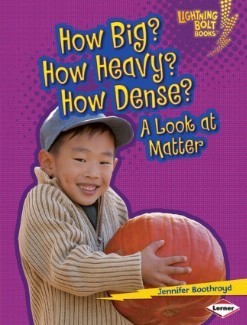How Big? How Heavy? How Dense? A Look at Matter
How Big? How Heavy? How Dense?
A Look at Matter
By Jennifer Boothroyd
Exploring Physical Science Series, Lerner, 2011
ISBN # 978-0-7613-6095-7
Ages 5-8
2011 ALA Conference is right around the corner. Visit the Nonfiction Book Blast to see the terrific program our panel has for you on Sunday, June 26 at 8:00 A.M. Stop by Lerner booth #916 to see some of these excellent books. Kelly, Carla, and I will be there right after our panel so please stop by and chat.
"Matter is everywhere in the universe. Matter is anything that has mass and volume. Mass is the amount of material in an object. Volume is the amount of space an object takes up."
How Big? How Heavy? How Dense takes the complex subject of matter and explains it in terms that early readers can understand. Building logically on the definition of matter, Boothroyd moves on to explain the properties of matter, the forms of matter, and how matter changes. Accompanying the text are large bright photos with captions that specifically illustrates the facts given. The choices for the photos were well done and relate to familiar objects that still highlights the information. Matter isn't an easy topic to explain and the book does it quite well.
The book concludes with a simple, kid-friendly activity that can be done without supervision. A glossary, further reading, and index complete the book. This book is a good way to introduce physical science and would be an excellent way to begin a lesson on matter for an overview before moving on to the textbook. For budding scientists, it's a good choice for reading as well. Simple but fact filled, it's a terrific, child-friendly book.
Activity 1
Create a density experiment. Gather a variety of waterproof objects, like a rock, penny, toy boat, paper clip, pumice, plastic toy or two, etc. List them on a chart. Have the students predict if the object will sink or float and mark their decision. Review the concept of density. Together, create a hypothesis. Then test the density of each object. Make a new column to record the actions and mark those changes.
Activity 2
Make a chart about the different ways matter can be sorted (classified). Use the information from the book and expand on the different categories. Include: colors, texture, shape, size, and, what it's made of, weight, and any other properties. Cut out pictures or bring in items and mount on the chart. Fill in with drawings. Discuss a title for the chart and how to organize things, and then create it. Label the chart items and headings.
This site has some good experiments that correlate with matter for this age.
Learn about density and volume with these experiments.
National Science Standards: properties of objects and materials
Book provided by Lerner Publishing.








Shirley Smith Duke's Blog




